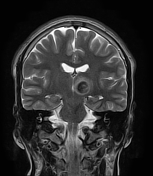238 results
Article
Thalamus
The thalamus (plural: thalami) is the largest of the structures comprising the diencephalon.
Function
The thalamus acts as a relay centre, receiving and distributing information between the peripheries and higher centres such as the cerebral cortices. It contributes to functions such as:
cons...
Article
Stria medullaris (thalamus)
The stria medullaris is a fibre bundle containing efferent fibres from the septal nuclei, lateral preoptico-hypothalamic region, and anterior thalamic nuclei to the habenula. It forms a horizontal ridge on the medial surface of the thalamus.
Article
Basal ganglia and thalamus signal abnormalities
Basal ganglia and thalamus signal abnormalities occur in a wide variety of conditions. Ischaemia/hypoxia, metabolic disorders and toxins, particularly those that affect the respiratory chain, have a predilection for affecting the basal ganglia as they are highly metabolically active.
They can ...
Case
Progressive multifocal leukoencephalopathy - thalamus

Published
15 Jan 2024
95% complete
CT
MRI
Case
Cavernoma - thalamus

Published
04 Mar 2019
77% complete
MRI
Case
Diffuse astrocytoma NOS - thalamus and brainstem

Published
08 May 2011
92% complete
MRI
Case
Right thalamus cavernoma with developmental venous anomaly

Published
22 Feb 2024
81% complete
CT
MRI
Case
Unilateral right paramedian infarction of thalamus and midbrain

Published
07 Aug 2019
80% complete
MRI
Playlist
thalamus and basal ganglia




10 cases
No description provided
Playlist
thalamus and basal ganglia




10 cases
No description provided
Playlist
Brain tumor - Thalamus-BG


2 cases
No description provided
Question
Question 400
In the accompanying axial image from a non-contrast CT of the brain, the thalamus is indicated by which letter?
Article
Déjerine-Roussy syndrome
Déjerine-Roussy syndrome, or thalamic pain syndrome, is a type of central post-stroke pain syndrome caused by a stroke to the thalamus.
This syndrome should not be confused with Déjerine syndrome or Déjerine-Sottas syndrome.
Epidemiology
Approximately 25% of all patients with sensory strokes...
Article
Velum interpositum
The velum interpositum is a small membrane containing a potential space just above and anterior to the pineal gland which can become enlarged to form a cavum veli interpositi.
Gross anatomy
The velum interpositum is formed by an invagination of pia mater forming a triangular membrane the apex...
Article
Choroidal fissure
The choroidal fissure, or choroid fissure, is a cleft of the medial surface of the cerebral hemisphere running immediately above the hippocampus and extends around the thalamus to the interventricular foramen of Monroe. It forms the medial wall of the lateral ventricle and attachment site for th...
Article
Creutzfeldt-Jakob disease
Creutzfeldt-Jakob disease (CJD) is a transmissible spongiform encephalopathy that results in rapidly progressive dementia and death usually within a year from onset. The vast majority are sporadic, but familial and acquired forms are occasionally encountered.
On imaging, it classically manifest...
Article
Papez circuit
The Papez circuit is a fundamental component of the limbic system. It is closed neural circuitry that starts and ends in the hippocampus. It is also known as the medial limbic circuit.
Gross anatomy
The Papez circuit involves different structures of the brain including 2:
hippocampus and adja...
Article
Artery of Percheron
The artery of Percheron is a variant of the posterior cerebral circulation characterised by a solitary arterial trunk that supplies blood to the paramedian thalami and the rostral midbrain bilaterally. From the original classification of arterial patterns at the origin of the paramedian arteries...
Article
Internal capsule
The internal capsule (TA: capsula interna) is a deep subcortical structure that contains a concentration of afferent and efferent white matter projection fibres. Anatomically, this is an important area because of the high concentration of both motor and sensory projection fibres 1,2. Afferent fi...
Article
Thalamic infarct
Thalamic infarcts refer to ischaemic strokes that affect the subcortical grey matter complex of nuclei known as the thalamus.
Epidemiology
Pure thalamic infarcts are reported to make up 3-4% of ischaemic strokes 1.
Risk factors
Most of the risk factors are common to all types of ischaemic s...









 Unable to process the form. Check for errors and try again.
Unable to process the form. Check for errors and try again.